How Fast Can Blogging Become Profitable? An Experiment.
It’s 2019 and I started the year deeply unsettled.
Don’t get me wrong. There were lots of good things going on. My partner had just gotten back from Asia, and I was relieved to have him home. My best friend came to visit, and I was so happy to see her and her family. We rang in the new year visiting chalet-covered Swiss mountain villages and castles with epic views.
But with work and creative projects, I’d hit an internal wall.
For the last few years, I’d been working part-time on income-generating opportunities and making space in my schedule for creative projects too. In those years, the creative projects I’d made time for had been fiction, something I loved to write back in high school and college and had lost sight of in the busy working years that had followed. A couple years into my new part-time schedule, I had two completed (and very different) manuscripts.
But I’d also hit an emotional snag.
I had a dozen other story ideas, but for a variety of complicated reasons, I wasn’t sure I wanted to write them. I wasn’t sure traditional publishing, my original goal, was actually the right path for me. I wasn’t sure self-publishing would be either. And so, with the heaviness of overwhelm and potential loss hanging over me, I’d taken a break. From querying agents. From thinking about new book ideas. From writing fiction.
That break was much needed, but it left a looming gap in its wake. And once the bustle of vacation and friends visiting had passed (and once I’d gotten over the horrible lingering cold that I caught at the end of that trip), that gap gaped endlessly ahead. I stared down into that empty space and wondered what I was supposed to fill it with if I was taking a break from fiction.
Not project work. I’d already learned my lesson about burnout and my health.
Not my normal outdoorsy activities. It was the dead of winter and I’m not a winter sports person.
So, if not fiction, then what? What kind of creative projects excited me? How would I spend the time I’d so studiously protected?
After weeks of mulling over my options and trying not to stare too hard into the void my fiction had left behind, partway into January, I decided on a project that straddled the line between creative and interesting and potentially something that might become a source of income.
I decided to start a second blog. All about European food.
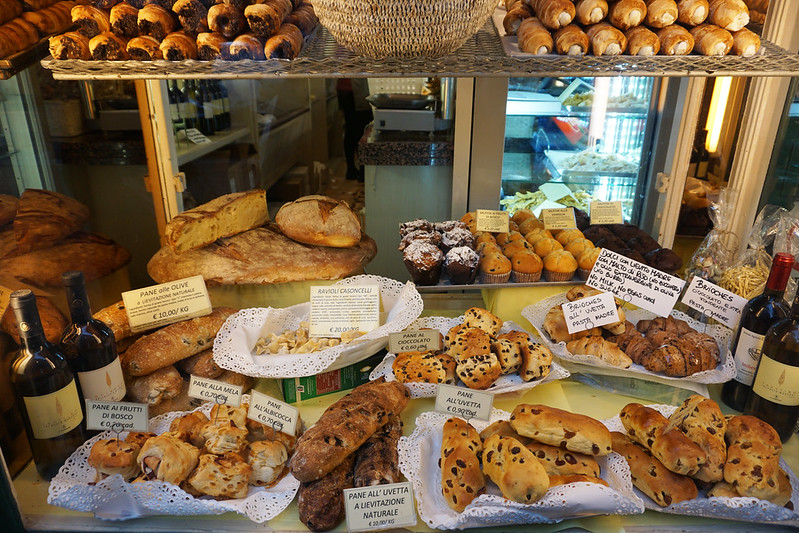
Enter Vicious Foodie
So, here are three truths that led me here:
1. I love food and I love storytelling. I’ve played with the idea of writing more about food here on the main blog, but those posts never get as much traction. Which makes me think perhaps this is the wrong place to do it. And perhaps I need a separate place to get really nerdy and snobby about all things European food.
2. I am a food snob, hard to please when it comes to food. I like to think that I’m never mean about it, but there aren’t that many restaurants that wow me. Most meals out are simply average. And while sometimes average is perfectly fine (especially if you’re starving and your original plans have been derailed), I wish desperately that there were more blogs out there that were really picky. More blogs that would feature just the one spectacular place in town instead of the 10 just fine ones.
Since I wish there were more blogs like that, I thought perhaps there are others who feel that way too. Perhaps my picky, snobby, foodie tastebuds could be the answer to someone else’s desperate wish.
3. I’m still intrigued by the idea of making income from blogging. I make a little money on this blog, but not much. And I’ve very intentionally not done a lot of things that would make this blog more profitable. Because this blog is something I do for the sheer joy of it and I didn’t want to change a lot of the things that have kept it smallish.
But I’m also curious: could I make real income from blogging? If I did all the things I know I’m supposed to do but don’t always do here?
And so a project emerged. I would start a new blog. It would feature all things European food – from very picky restaurant reviews to explanations of local dishes to historical tidbits (like, for instance, did you know that fondue became popular in Switzerland not organically but because of advertising?).
But the blog wouldn’t just be a passion project. I would also do everything in my power to monetize it in a quest to find out if everything I’ve learned over many years of blogging still holds true, if I could make real money from blogging if I followed the rules, and how quickly a blog can start making money.
I decided to give the project a year. Because these kinds of experiments are always more interesting with a defined timeline. What can a blog started from scratch do in a year?
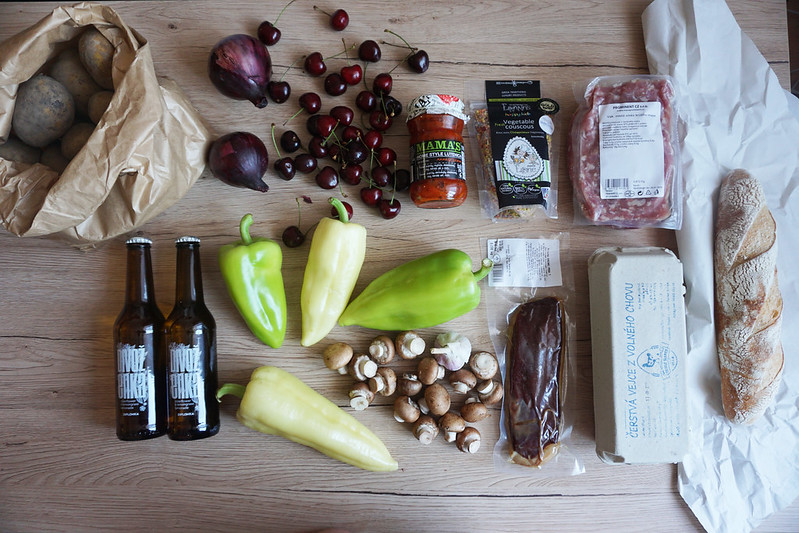
Documenting the Journey
As soon as I started to dive into the new project, I realized it would probably be valuable to share it here.
Because I get emails often asking me how to make money from blogging. So whether the money side of this ultimately succeeds or fails, seeing what I did (and perhaps what I didn’t do) can only help if you’re also thinking about blogging.
And so I’ll be regularly (probably monthly) updating you on the steps I’ve taken, the number of readers I’ve got (according to Google), the income the blog has generated (if any), and what I plan to do next.
If that sounds interesting, here’s your first breakdown: What I did and made in January 2019.
Step One: Building the Site
For many, this is probably a daunting step, but I’ve been building websites since I was 14 (that’s 20 years, for those wondering my age). For a small website with only a couple pages to start, the build process only took me a few days.
Here’s a free course if you want to see my entire process from strategy to launch laid out in detail. The extremely short version is that I started with strategy: Who was the site for? What were my goals? Then I decided on what pages I’d have and wrote (and optimized for SEO) the content on the core pages I’d launch with. Then, with the content already written, I chose a design. Then I customized it.
I still didn’t share it anywhere. Because I wanted to get a little stockpile of blog posts before I started sharing.
Seeding it with Content
Once I had a site, I needed to let Google (and readers) know it was going to be robust and substantial. I wanted to get a bunch of posts up pretty quickly so that the blog felt “lived in.” And then I’d settle into a more evenly paced publishing schedule.
By the end of January, I’d published 10 articles and queued up another dozen+ to publish 2 – 3 times per week in February and March.
Content Types
Before starting to write, I already had a list of the types of content I’d be writing. Restaurant reviews were a given. They were a big part of the frustration/hope that had led to the site. I also wanted to feature other food establishments like cafes, bakeries, specialty shops, and fresh markets. Cooking classes are one of the best ways to find really great food in a place, so I knew I’d write about those.
Those reviews would be the core of the site. The purpose for which it was started. But they wouldn’t be all I spent my time on.
I also wanted to interview chefs about their favorite foods and favorite places to eat. That kind of content would be interesting, would let me extend my foodie umbrella to places I hadn’t tried myself yet, would (selfishly) point me toward more places to try, and would be likely to be shared on social media and/or linked to from other related sites (both of which are great for generating more blog traffic and increasing SEO/Google rankings for my site).
Finally, some of the content on the site would be purely dictated by SEO. I’d use keyword research tools to figure out what questions people were asking about European food, restaurants, and food culture and I’d write answers to those questions.
Things like “what is fleur de sel?” or “what is Breton cuisine?”
Everything would circle the concept of the best and worst of European food and these would be the starting categories. Each post would also be tagged by place so that people could navigate content for a specific town or region they wanted to visit.
SEO Considerations
Now, let’s talk about some of the nitty gritty of post creation. For each post that I wrote, I focused on several core areas:
First (and obviously), I wanted the content to be interesting and useful for readers. Without that, no amount of SEO or social media or marketing efforts would save the blog from failing.
Second, I needed each post to be optimized for SEO. (If you’re not familiar with SEO, Moz is a great place to start learning.)
The basics are this: SEO (search engine optimization) is optimizing your posts (or pages) to appear and rank highly in search engines. There are a lot of moving pieces, so if you’re new to it, there will be a learning curve. I’ve been doing SEO work for probably about 15 years, so I’m well versed in the content side of things, though I’m still learning the tech side and new things that come with the constant changes Google and other search engines make to their algorithms.
Without getting too into the weeds here, for me, early per post optimization meant:
:: Researching keywords that were relevant to the topic I wanted to write about (or researching keywords and choosing a topic based on the questions people were already asking search engines)
:: Using those keywords where relevant on the page
:: Writing a meta description for each page (using keywords where relevant)
:: Writing a descriptive browser title for each page (using keywords where relevant)
:: Writing posts with lots of sub-headers and short paragraphs (which is both more readable and better for search engines)
:: Writing alt tags for images (using keywords where relevant)
Social Media Strategy
The third thing I did on every post was try to make it social media-friendly. This meant including plenty of images (which is also more user-friendly, so win-win) and creating a special Pinterest image with image + text so that people could pin my page on Pinterest.
I should pause here to say that Pinterest is a huge traffic source for many bloggers, so if you’re going to start your blog spending time on only one channel, this is the one many bloggers would recommend.
This blog doesn’t get much Pinterest traffic (mostly because I’m lazy about doing anything Pinterest-related for it), but for the experiment, I’ll be trying to tap into the power of that platform.
I also made sure to put share buttons on my site first thing. Once traffic did start coming to the site, I wanted to make sure people could share on Facebook or Twitter if they wanted to.
Pinterest images ended up looking like this:


Link Strategies
Now, one of the most important things any blogger can do both in terms of getting new readers/word of mouth and in terms of ranking in search engines is getting links. This means two things:
1. Getting sites that are relevant to what you’re doing to link to your content. (e.g. travel sites if your site is about travel; food sites if your site is about food; parenting sites if you’re talking about motherhood)
This gives your site clout in the eyes of search engines. Because relevant, reliable sites aren’t going to link to things that are garbage or scams or full of incorrect information (I mean, mostly, right?). It also shows that you’ve got something others judge as worthwhile to say.
The more links you have from high quality sites in your niches, the better your overall site value is going to be in the eyes of Google.
2. Cross-linking to your own content throughout the site. Search engines (and readers) also really value being able to dig deeper into a topic or navigate to related things on the site. When you link between related posts, you’re telling users they’re relevant to each other and you’re telling search engines the same thing.
As part of my link strategy, I published content in clusters. If I wanted to post about a restaurant in Dinan, France, I also scheduled other content from that region (Brittany). About what dishes are popular in Brittany or where to get good baked goods in nearby Rennes or how the region has the second largest fresh market in France.
I wanted Google to know that my site was about Europe and that I’d be particularly talking about France, Italy, Slovenia, and Switzerland, where I have had a lot of great foodie experiences.
I didn’t do much with external links in January, as I wanted to get some content live before I did, but I did add some relevant links from this blog to that one and I did start making lists of fellow bloggers I’d reach out to about guest posting or doing interviews starting in February.
Mailing List Setup + a Freebie
If seeding the site with content and making sure it was optimized for SEO and Pinterest were my top two priorities, my mailing list was a close second. Industry wisdom is that people who sign up for a mailing list are much more valuable (in terms of being likely to buy from you, click on affiliate links, etc.) than casual browsers. If you read any blogs on how to get started blogging, almost every blogger will tell you the thing they wish they knew earlier was to build their mailing list from the start.
Now, I’m not ready to actively start promoting it yet (and, in fact, I was still being very quiet about the new site), but I wanted to get a mailing list set up (through MailChimp) and create a valuable freebie people would get if they signed up.
For the freebie, I used Canva to create a pretty PDF of foodie suggestions for France, Italy, Slovenia, and Switzerland (my first four target countries). I used a menu layout to make it feel like a mock menu and created a cover that was a collection of some of my favorite food photos as well as a title.
If you’d like to take a look at the full freebie, you can join the Vicious Foodie mailing list. (See how that works?) You’ll also get to see what the newsletters look like and evolve into over time.
Affiliate Links + Legal Mumbo Jumbo
Finally, legal compliance had to be a quick priority. There are a few different legal bits that bloggers are subject to. The big one is GDPR/privacy laws. For this, you need a privacy policy page on your site that talks about what data you collect from users (comments? A contact form? Google Analytics tracking?), how you use it, whether you sell it, and where they can contact you if you’d like you to delete their comment/email/whatever.
(Keep in mind here that I am not a lawyer and this is not legal advice. If you’re concerned about complying with privacy laws, consult a real legal expert. End disclaimer.)
Another legal compliance thing to be aware of from the start is that if or when you start using affiliate links (links that earn you a commission on sales) or doing sponsored posts or ads on your site, there are laws in the US that require you disclose those links/ads/sponsored posts and disclose them clearly and quickly.
For me, this means that when I talk about a free hotel stay, even though I’m giving my honest opinion, I include a line or two at the top of the post that says the stay was free. If I’m including affiliate or sales links, I say so at the top of the post.
I also have a disclosures page that talks about my policies with ads and freebies and all that jazz so that things are clear if people want to read about it (pro tip: they don’t, though).
The page is boring and boilerplate on the new site, but I got it up quickly to make sure it’s there and compliant.
January in a Nutshell
January was obviously a huge month. In just a few weeks, I took on a lot. Most bloggers wouldn’t go quite this fast (and, indeed, it’s probably a bad idea to try and replicate this speed), but I’ve built so many sites and written so much content over the years that I’m rather speedy at it now.
Ultimately, I ended the month with a nicely designed site and a solid foundation of content.
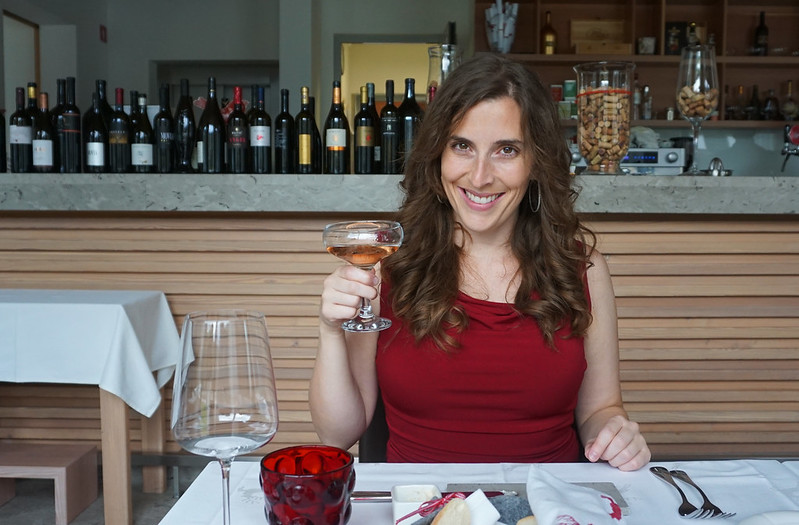
The Cost of Blogging in January
Starting up a blog comes with some concrete costs. The first and most essential was buying my new domain name (viciousfoodie.com), which cost $9.06 (annual, yearly fee) through NameCheap.
I also purchased a theme (design) for $61 (one-time cost) from ThemeForest. There are free themes out there and some are great, but I’m willing to spend money if I find a paid theme that really fits what I’m looking for.
I already have website hosting (through NameCheap) for up to three sites, so there was no additional cost to me there. If I’d purchased new hosting, the cost would be $15.44 per year at the time of this writing for shared hosting through NameCheap.
Finally, the largest (and non-essential) purchase I made was a yearly subscription to Keysearch, which ran me $135.20 because a friend gave me a coupon for 20% off (to get 20% off yourself, use my link above and code DNW30).
This is a keyword research tool that helps me assess how many searches people do for things like “what is kouign-amann” or “best restaurants in Dinan.” It also shows me how hard it will be to rank for them and what other sites are currently showing up in Google for those keywords. This helps me determine where the gaps are. Where can I provide unique value or better content on a topic…and where should I step aside because others are already doing it well?
I normally wouldn’t make such a hefty purchase when I’m just starting a new project, but I justified it to myself by promising I’d do a little more SEO here on this blog and perhaps use the tool for client work in the near future, since I have a client that wants some SEO help and free tools won’t cut it for that.
I should also potentially mention Flickr. I love Flickr and use it as both a photo backup and a place where I store and link to photos on this blog and now the new blog. I already had a pro account on Flickr, but if I hadn’t and if I’d wanted to sign up in order to organize and store photos for the new blog (optional because you can store photos in WordPress; I just find Flickr a lot easier to navigate), the cost would be $99.98 per year.
So, my total actual costs in January for blogging were $205.26. And if I’d had to purchase hosting and Flickr, the total would have been $320.68.
If I was just starting out and had chosen free keyword tools, free theme/design, and free photo storage, I could have spent as little as $24.50 and still had a self-hosted blog on my own URL. And if you’re starting out with no budget, you could actually start a blog with $0 on a shared blogging platform like WordPress.com (and then you could switch platforms later as needed).
January Readership on my Blog
In January, I had 72 unique visitors to my blog. For a blog that I wasn’t really actively promoting yet, I’m okay with that number, which was mostly made up of you nice folks here at gigigriffis.com who clicked through on a link I posted about the new project in my link round-up in late January.
In the chart below, you can see that I started the blog mid-month and started to get readers late in the month when I started very lightly promoting it.
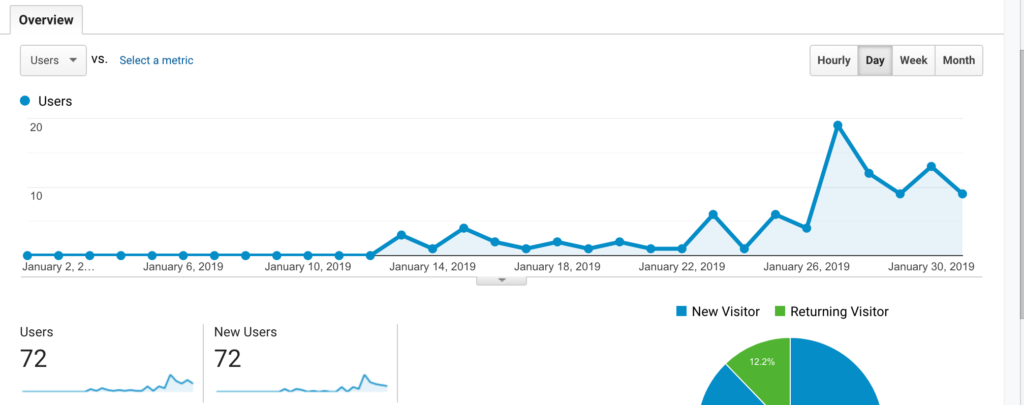
How Much I Made Blogging in January
As you might expect, the number in January was $0. I’ve got a couple affiliate links up on the blog already, but with 72 visitors, it’s unlikely anyone’s clicking through and buying things.
Now, a caveat here is that this is going to be tricky to track. I already have affiliate accounts with companies I like like MasterClass and NameCheap and I already use affiliate links to point toward products I like on Amazon and it felt rather silly to open new affiliate accounts for each one for the new blog, so I’m using my existing accounts.
This means it’s going to be tough to figure out which sales come from this blog and which ones come from Vicious Foodie. I haven’t dug into the details yet to see if I can see where the sales came from, so we’ll see how accurate this can and will be in future.
Phew. That was a lot to download.
Any questions? Suggestions? Blogging tips that worked well for you? Things I’ve missed that should be top priority? Drop them in the comments.
More monthly reviews:
Comments
-
-
Ali
Congrats on the new site! I’m really excited for you and interested to see how you do with it over the year. Let me know if you want any help with affiliate related stuff. You mentioned not being able to track exactly which site affiliate sales come from, you can set up multiple tracking IDs in Amazon (and you need to tell Amazon about your new site) but it’s all in the same account. Then you can look at your reports in Amazon and filter out whichever IDs you want info on. I have at least a dozen just for one site so I know which part of the site the sales come from. There are similar ways of splitting sites in places like CJ and Shareasale too, in case you end up in any of their affiliate programs.
-
Emily Peppers
Love love LOVE the spending, readership, and income details. Thanks for being honest and willing to share! Also, thanks for continuing to keep The Ramble relatively free of annoying ads and other things that can make sites less user-friendly. 😀 It seems like SO many of my favorite blogs have gone the clearly-just-trying-to-make-a-buck route and are covered in ads for things like insurance companies and cleaning products. 😛
-
-
Kyra Rodriguez
Congrats on your 2nd blog!!! And, can’t wait to see the outcome!!! Thanks for sharing this!
-
Willow
It’s cool to hear about how you approach SEO, Gigi. I’ve been toying with buying a subscription to Keysearch but I’m just not sure if I can justify it financially yet. I think my big focus right now needs to be building links with other similar blogs
Will you keep us updated?
-
Sheri Doyle
I love that you have started a blog dedicated to food. I too get frustrated with average food, and even angry with tourist food. There are two amazing restaurants in Europe I can whole-heartedly say provide food, service and atmosphere that is hard to find anywhere else in the world. Just in case you are interested they are:
https://www.ristoranteforassiepi.it
his food is nothing short of exquisite. I eat here several times a year and each time it is extraordinary.https://pelegrini.hr was just given the title of the best restaurant in Croatia. It is located in a perfect spot in Sibenik. The food and service are life changing. After we misunderstood the bill and underpaid by ALOT we found out on our next visit just how extraordinary they are as well.

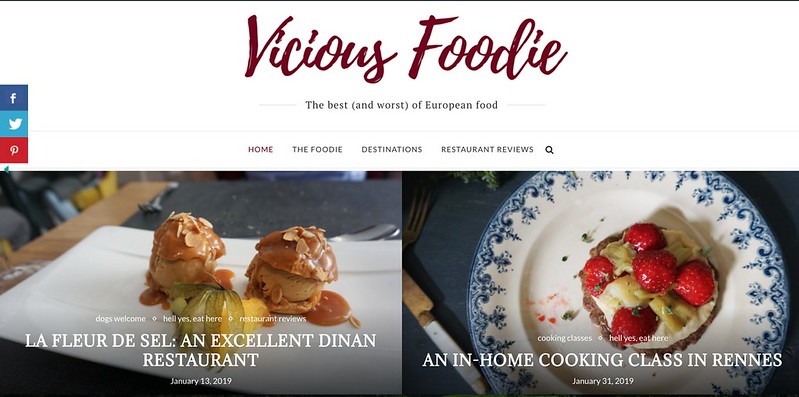
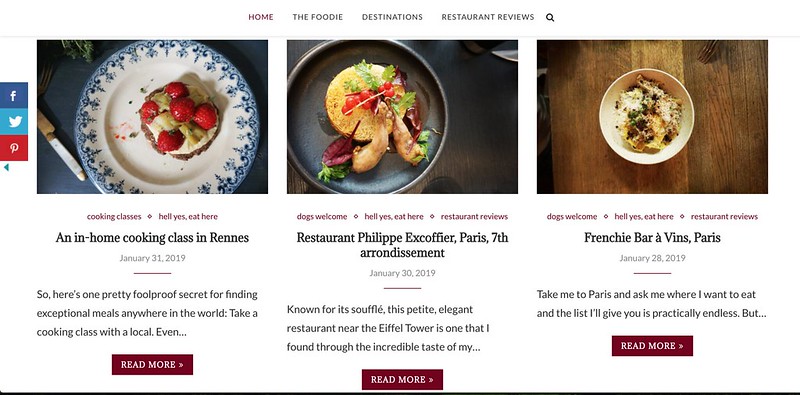
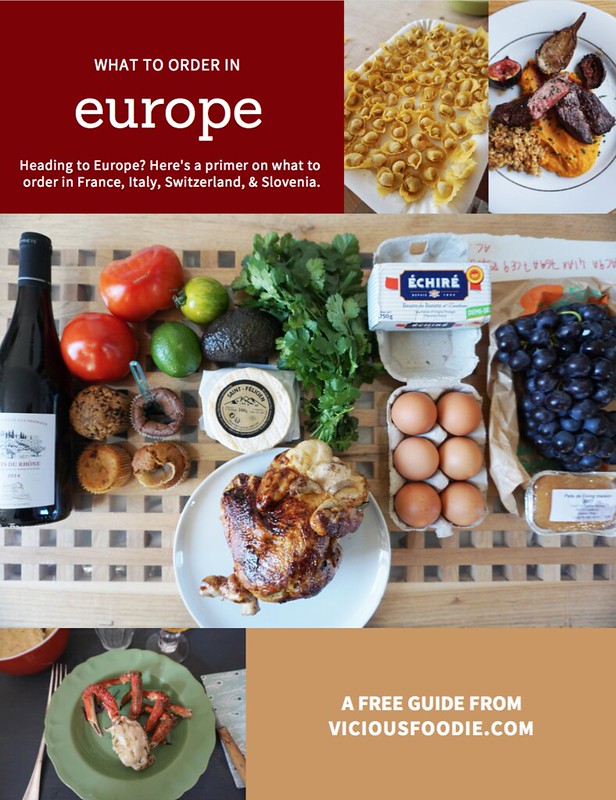
Sonja Lishchynski
I will have to watch this… I have been wanting to do something like this but based 100% on vegan and sustainable foods only. I shall be watching. 🙂